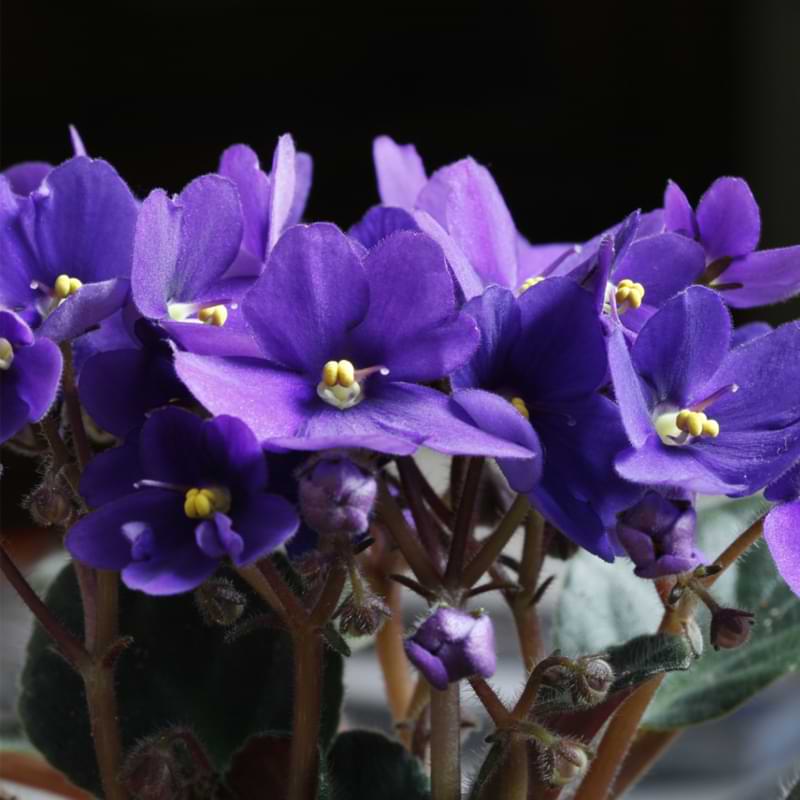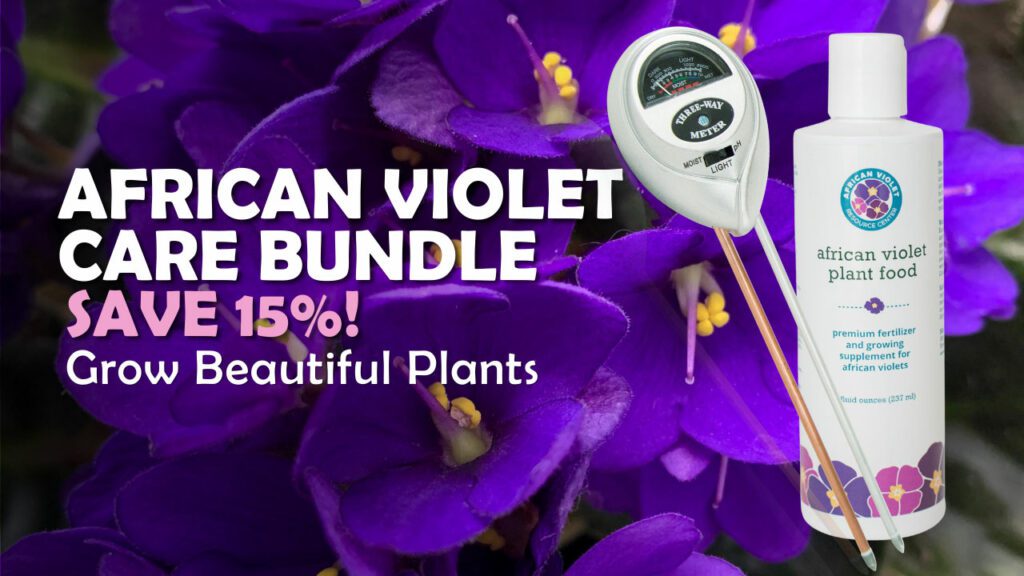African violets are a popular, beloved houseplant for good reason. In addition to being prolific bloomers, they are also relatively easy to care for. Even people who can’t keep anything else alive can usually manage to keep African violets going.
Of course, for an African violet to thrive, it does have a few specific requirements. With just a little time and attention, anyone can easily keep these beautiful plants happy.
In this guide, we’ll go over everything you need to know to begin caring for your African violets.
African Violet Facts
Common Name: African violet
Botanical Name: Streptocarpus ionanthus
Seasonality & Life Span: bloom 10-12 months a year, life span of up to 50 years
Flower Color: blue, purple, white, pink, or a combination
How to Grow and Care for African Violets
As far as houseplants go, African violets are one of the easiest plants to care for. They require a little fussing over in order to persuade them to bloom over and over, but it’s very easy to keep the plants alive.
Position
African violets do well indoors in a sunny window where they get bright, indirect light. As long as the plants are away from drafty areas or air vents, they will do well basically anywhere indoors with a lot of light. Usually this means placing your African violets in a window that faces west or south, but it depends on your home.
How big can African violets get?
African violets are generally classified into 3 different sizes. They sometimes can get bigger than their classification, but it isn’t too likely.
- Miniature African violets usually grow up to 8 inches wide.
- Standard African violets grow between 8 and 16 inches wide.
- Large African violets grow more than 16 inches wide.
Typically, you’ll know which kind of African violet you have when you buy it. Miniature and standard African violets are more commonly available than large African violets.
Temperature
African violets do so well as houseplants because they thrive in the average home environment. African violets prefer the temperature to stay around 70 degrees Fahrenheit. Avoid allowing your African violets to be in an environment where the temperature drops below 60 degrees or rises above 80 degrees Fahrenheit.
Excessive cold temperatures are more damaging to African violets than excessive heat. That being said, my African violets have been fine for several hours indoors without heat when the power has gone out during the winter. So don’t immediately panic if your plants are exposed to a cold that is beyond your control.
In addition to warm temperatures, African violets also need an average amount of humidity. In the wild, they prefer 70 to 80 percent humidity, which is not advisable to replicate at home. Instead, try to keep the humidity at around 50 percent and your African violets will be fine. In most homes, this should not be a problem, but in some areas, you may need to use a humidifier during the winter months.
Light
An African violet’s light requirements are the only tricky part about caring for African violets. African violets can survive with as little as 6 hours of sunlight a day, but they won’t bloom with that little sunlight.
Instead, you’ll need to provide 8 to 12 hours of light a day to see the most prolific blooms on your African violet. Finding a window in your home that provides enough light can take some trial and error.
African violets can bloom between 10 to 12 months of the year, but they need enough sunlight to do so. During the winter, you may need to supplement the natural light with artificial light if you want your plant to continue blooming. It’s also okay if you don’t provide extra light. Even if your African violets don’t bloom year-round, they are still attractive in the winter months thanks to their fuzzy, vibrant leaves.
Watering
African violets are fairly forgiving when it comes to water as long as you do not overwater them. Water your African violet whenever the soil has almost dried out. You should be using a potting mix designed for African violets because it will hold on to just enough water while allowing excess water to drain. Be sure that your African violet’s container has drainage holes to allow extra water to escape.
Overwatering is the most common reason why African violets die. Too much water can cause root rot or crown rot, while an occasional underwatering will not cause as many problems. That being said, don’t neglect your African violet for weeks and expect it to survive.
Watering from the top can allow small droplets of water to discolor the leaves. This doesn’t look great, but it does not harm the African violet. Still, you should water from the bottom if you want to avoid leaf spotting.
Watering from the bottom just means filling a tray or other container with ½ inch to 1 inch of water and then placing the African violet in the tray. Make sure the water reaches the drainage holes so the soil can absorb water. Allow the plant to soak for about 20 minutes before removing.
On average, you should expect to water around once a week. However, this depends on factors like the temperature, the season, and even the size of the African violet. Remember to check to see whether the soil is dry before watering.
Learn more about watering in our article The Best African Violet Watering Methods for a Happy Houseplant.
Fertilizing
Houseplants usually need some kind of fertilizer because they only have access to a limited amount of nutrients. African violets are no exception. Small amounts of fertilizer will help your African violet thrive.
Look for a balanced formula, one where the NPK levels are equal or close to equal. Liquid formulas allow you to easily control the amount of fertilizer you apply. I’d suggest diluting the formula even more than the packaging calls for or using a gentle fertilizer that you can apply weekly.
Overfertilizing can actually harm African violets, so don’t go overboard.

Flowering
Although African violets have beautiful, attractive leaves, most people are more interested in the blooms. African violets can be prolific bloomers, and they can provide color during times of the year when other houseplants are no longer blooming.
How long do African violets flower?
Individual African violet flowers can last anywhere from 2 to 3 weeks. With the right care, African violets will bloom anywhere from 10 to 12 months a year. African violets can be a bit finicky, so you may have to spend time making adjustments to get them to bloom quite that long, but it is possible.
How do you get African violets to bloom again?
There are several reasons why African violets don’t bloom. Most of the problems are easy to fix once you identify the issue.
Lack of light is the most common reason. You won’t see blooms if your African violets get less than 8 hours of light a day, and most of the time, African violets need anywhere from 8 to 12 hours of light. You can try moving your African violets to a different window or try supplementing using artificial light to encourage more blooming.
African violets will also stop blooming if they are overwatered or underwatered. Once you correct the watering schedule, the plant should recover and begin blooming again.
Additionally, African violets may stop blooming if you aren’t providing fertilizer correctly. Although African violets only need small amounts of fertilizer, they may stop blooming if they aren’t getting enough. This problem is much less common than lack of light or incorrect watering, but it can sometimes be an issue.
If the light, water, and nutrients are adequate, your African violets will continue blooming most of the year. However, there are a few other less frequent reasons why African violets stop blooming. Learn more about these problems in 6 Reasons Your African Violet Won’t Bloom and How to Fix Them.
Deadheading African Violets
There’s no reason to leave dead flowers on your African violet. Once a flower has finished blooming, use clean scissors or a clean knife to remove the faded flowers. There is a small chance that dead flowers can allow rot to develop, but the main reason to remove the spent flowers is because they will distract from the beauty of the new blooms.
Potting & Repotting
African violets should be potted in small, shallow pots. The diameter of the pot should be about one-third of the diameter of the African violet’s leaves. Choose a pot with drainage holes that allow excess water to drain from the pot. Don’t let the decorative pots without drainage holes tempt you—it’s just too easy to overwater without drainage holes. It’s also important to use potting soil designed for African violets. Regular potting soil is too dense and holds on to too much water.
Wondering when it’s time to repot your African violets?
The recommended repotting schedule is once or twice a year. If you tend to put this kind of task off, you should repot before your plant becomes root-bound, at the very least.
When you repot, be sure to use fresh potting soil. Move to a larger pot if your African violet is outgrowing its current pot. Otherwise, you can wash and reuse the same pot. If moving to a larger pot, look for a pot that is only about 1 inch larger than the previous pot. Pots that are too large will allow the soil to remain moist for too long and potentially cause root rot or other problems.
Can you repot African violets when they are blooming?
Repotting African violets while they are blooming can cause stress, but you shouldn’t delay repotting due to blooms. If you provide excellent enough care for your African violets, they may not stop blooming too often. Go ahead and repot when it’s time to repot.
If you are careful when you repot, you may not see any change in your African violet after repotting. Even if you do see some signs of stress after repotting, your plant will be healthier in the long run if you repot when needed.
Propagation
Another great thing about African violets is that they are easy to propagate. You can successfully take cuttings or divide African violets to create new plants for yourself or to share with friends. You can even grow new African violets from seed at home, although this takes considerably more time and patience.
The most common way to propagate African violets is through leaf cuttings. To grow new African violets this way, choose several healthy leaves from a mature African violet. Cut the stems from the original plant, and then make a 45-degree angle cut at the bottom of each stem. Place the cuttings in a container filled with African violet potting mix. Cover the container with a plastic bag or lid to keep in moisture. Place the container in a sunny spot with indirect light. Water frequently enough that the soil does not dry out.
After about 8 weeks, tiny new plants should begin emerging. Allow the plants to develop 3 to 4 leaves before potting them on their own. In several months, you’ll have new mature African violets that are ready to bloom.
Pests & Diseases
The biggest danger to African violets is overwatering, which can lead to root rot. It’s easier to prevent root rot than to treat it. Be sure to wait until the soil is almost dry before watering, and use a container that allows excess water to drain.
Mealybugs and cyclamen mites are the most damaging pests that are attracted to African violets. Before bringing new plants into your home, closely inspect the plants for pests. Serious infestation may require isolating or even destroying infected plants. Sometimes insect sprays can help control pests after you’ve found them, however, it’s much better to keep pests away in the first place than try to get rid of them later.
To treat insects, be sure to use a plant safe neem oil or our Leaf Armor spray.
African Violets Frequently Asked Questions
Hopefully this guide has helped you feel more confident about caring for your African violets. They are lovely plants, and every household should have at least one or two. Before you go, here are a few more questions that people sometimes have about African violets.
FAQ: Why are the bottom leaves of my African violet dying?
First of all, don’t immediately panic if the bottom leaves of your African violet are dying. African violets grow new leaves from the crown, so it’s normal for the older leaves at the bottom to die over time.
However, if all the older leaves are turning yellow or drooping at once, root rot may be an issue. Root rot happens when African violets are overwatered and the roots are damaged. You’ll notice symptoms in the lower leaves first, but in time, the entire plant can die if the problem isn’t corrected.
Adjust your watering schedule. Make sure you allow the soil enough time to dry out between watering and treat with a root supplement. African violets are resilient. As long as you catch the problem early, your plant will most likely recover.
FAQ: Do African violets go dormant?
You might be surprised to learn that African violets do not typically go dormant when grown indoors. As long as the environment provides enough light and warmth, your African violet will continue growing even when everything else green has stopped.
Join the African Violet Club!
Whether you’re just starting out or are a seasoned grower, African Violet Resource Center has everything you need to help your plant grow vibrant and strong. Explore our other articles, visit our online shop, and connect with other houseplant lovers in our Facebook group to learn everything you need to know about this rewarding hobby!
More Great African Violet Resources
Why Are My African Violet Blooms Dying?
A Quick Primer on African Violet Pots







